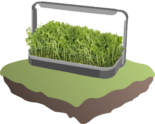Table of Contents
ToggleGrowing Alfalfa (Alfalfa) Microgreens: From Seed to Plate
Alfalfa, also known as Lucerne, is a favorite in the microgreens family, valued for its nutritional richness and culinary versatility. Microgreens are the young shoots of plants that are harvested before full maturity and have gained increasing popularity in the health and gastronomy world thanks to their high nutritional content and aesthetic appeal.

Preparation of Alfalfa Seeds
- Selection of quality seeds: It is essential to choose high-quality seeds to ensure healthy growth. Search for organic and GMO-free seeds from trusted dealers.
- Watering and soaking: Soak alfalfa seeds in cold water for 4-6 hours before sowing to speed up the germination process.
Sowing and Starting
- Selection of plant pots: The choice of planter can vary from plastic trays to ceramic pots, but good drainage is essential.
- Sowing techniques: Spread the seeds evenly over the soil surface and cover them lightly with soil. Seed distribution is key to avoiding overpopulation.
Light and Temperature
- Lighting requirements: Alfalfa microgreens thrive best in bright but indirect light conditions.
- Temperature conditions: A constant temperature of around 15-20°C is ideal for germination and growth.
Watering and Care
- Watering patterns: Water lightly but regularly, making sure the soil remains moist but not wet.
- Overwatering and underwatering: It is vital to find a balance to avoid root rot or drought-stressed plants.
Harvest and Storage
- Harvest time: Harvest alfalfa microgreens when they are 3-5 cm in height, typically after 7-14 days.
- Storage: Store the harvested microgreens in an airtight container in the refrigerator to maintain freshness.
Nutritional Benefits of Alfalfa Microgreens
Alfalfa microgreens are an excellent source of vitamins and minerals that can boost your overall health and well-being.
Using Alfalfa Microgreens in Cooking
From salads to sandwiches, there are countless ways to include Alfalfa microgreens in your daily diet and enjoy their fresh taste and nutritional benefits.
Conclusion and Inspiration
Growing alfalfa as a microgreen is a simple, nutritious, and sustainable way to add freshness and nutrition to your diet. Let this guide inspire you to start your own microgreen project and experience the many benefits of growing your own food.
Do you have questions? We have answers!
What is alfalfa good for?
Lucerne is well known for its popularity as a structural forage and is often used to mix with the horse's manger feed. This helps to prolong chewing time and stimulate saliva production. The product is enriched with molasses and acts as an excellent and natural source of energy, protein and lysine.
Why feed alfalfa?
Rich in Protein and Lysine
Lysine is one of the essential amino acids that the horse cannot produce itself and must therefore be supplied via the diet. Lucerne naturally contains a significant amount of lysine and is therefore an excellent choice to support the building of muscle mass.
Is alfalfa perennial?
This is a perennial plant with flowers belonging to the pea family.
Is alfalfa a nitrogen fixer?
Clover and alfalfa are plants capable of nitrogen fixation. This means that they can convert nitrogen from the air into ammonium and nitrate with the help of tiny nodule bacteria that live on their roots.
Is alfalfa concentrate?
Many forms of concentrate already contain alfalfa. This has the advantage that your horse also receives valuable fiber and has to chew its feed for a longer time. In these concentrate mixtures, the high calcium content is usually balanced with other feed components.
